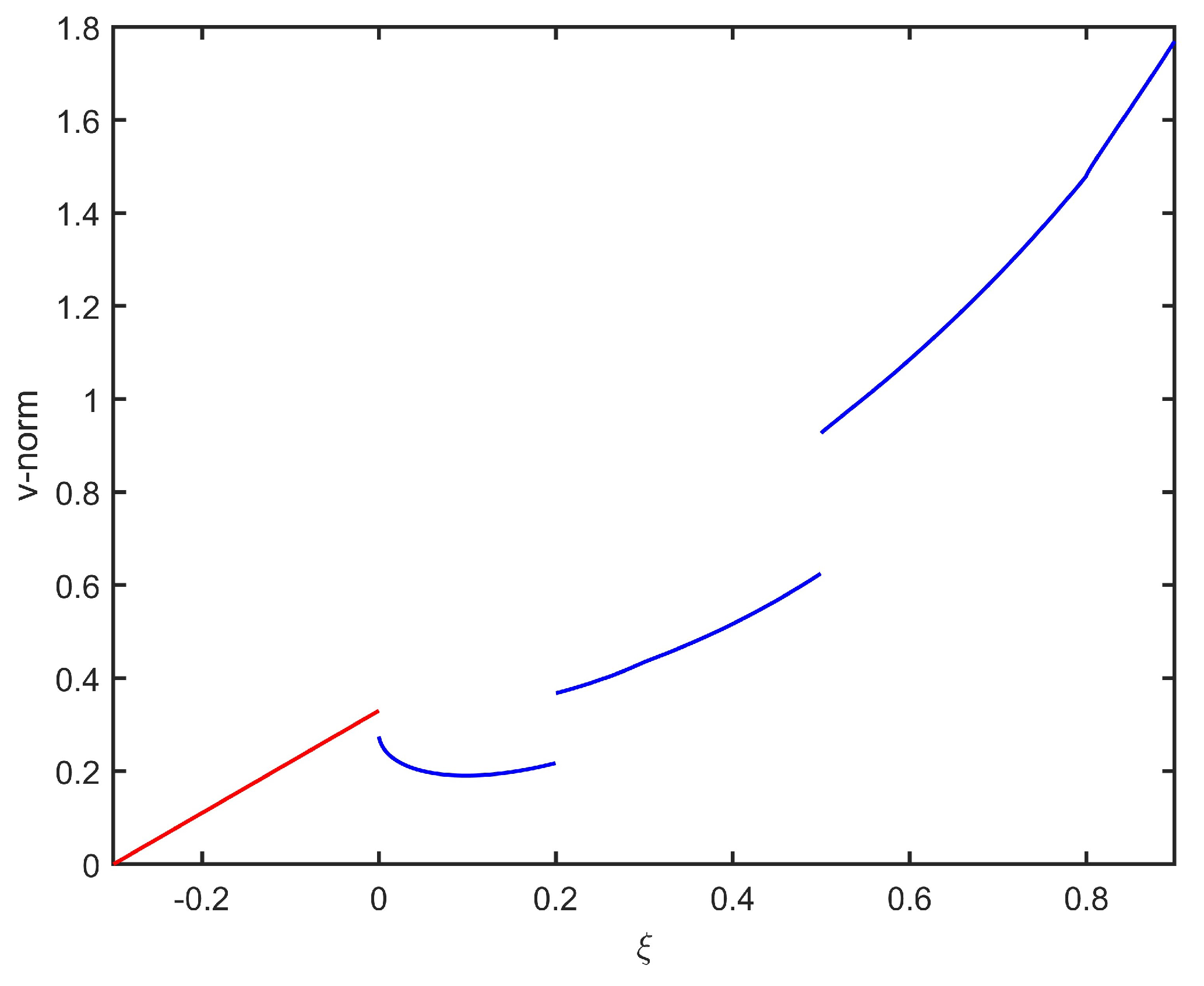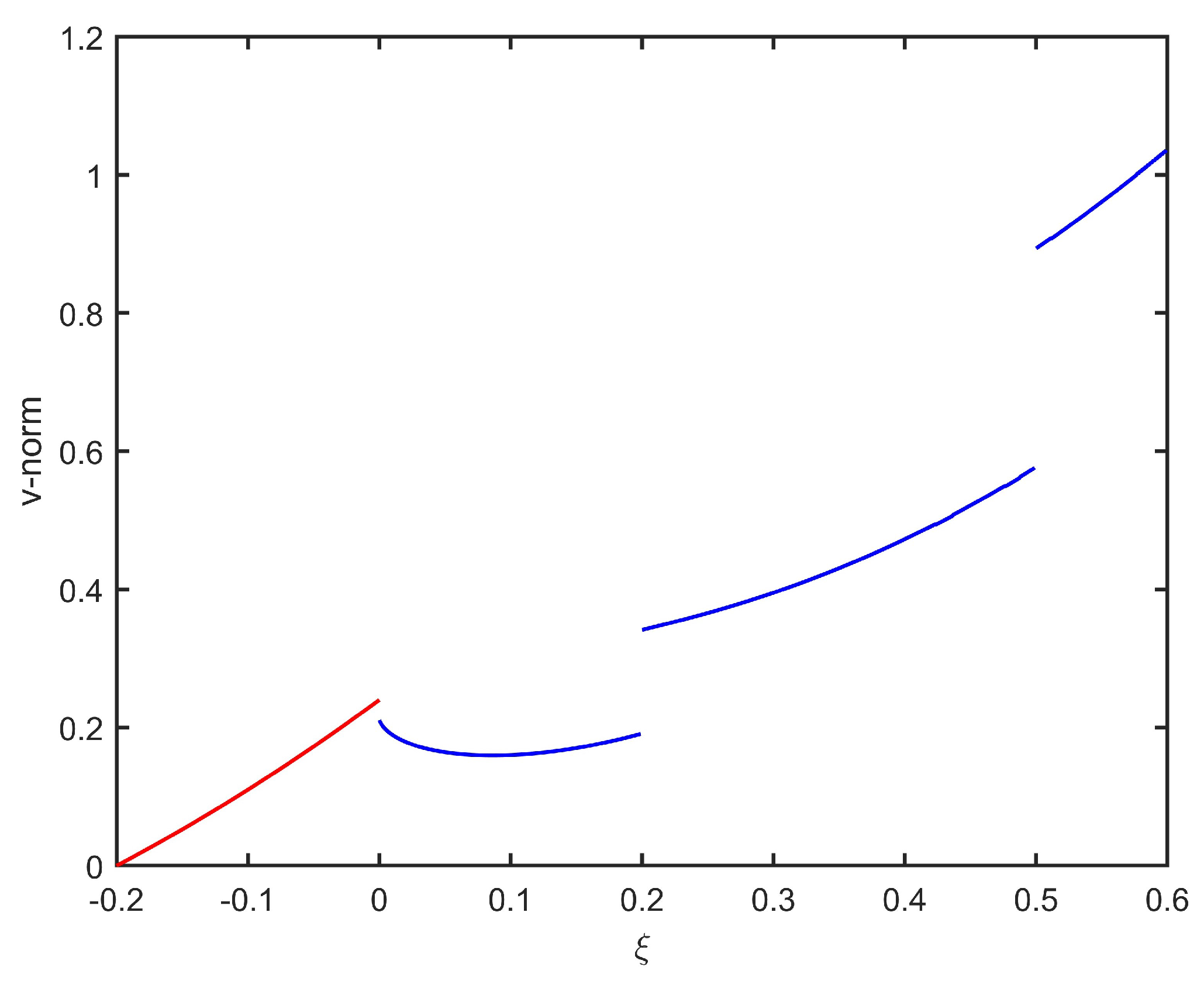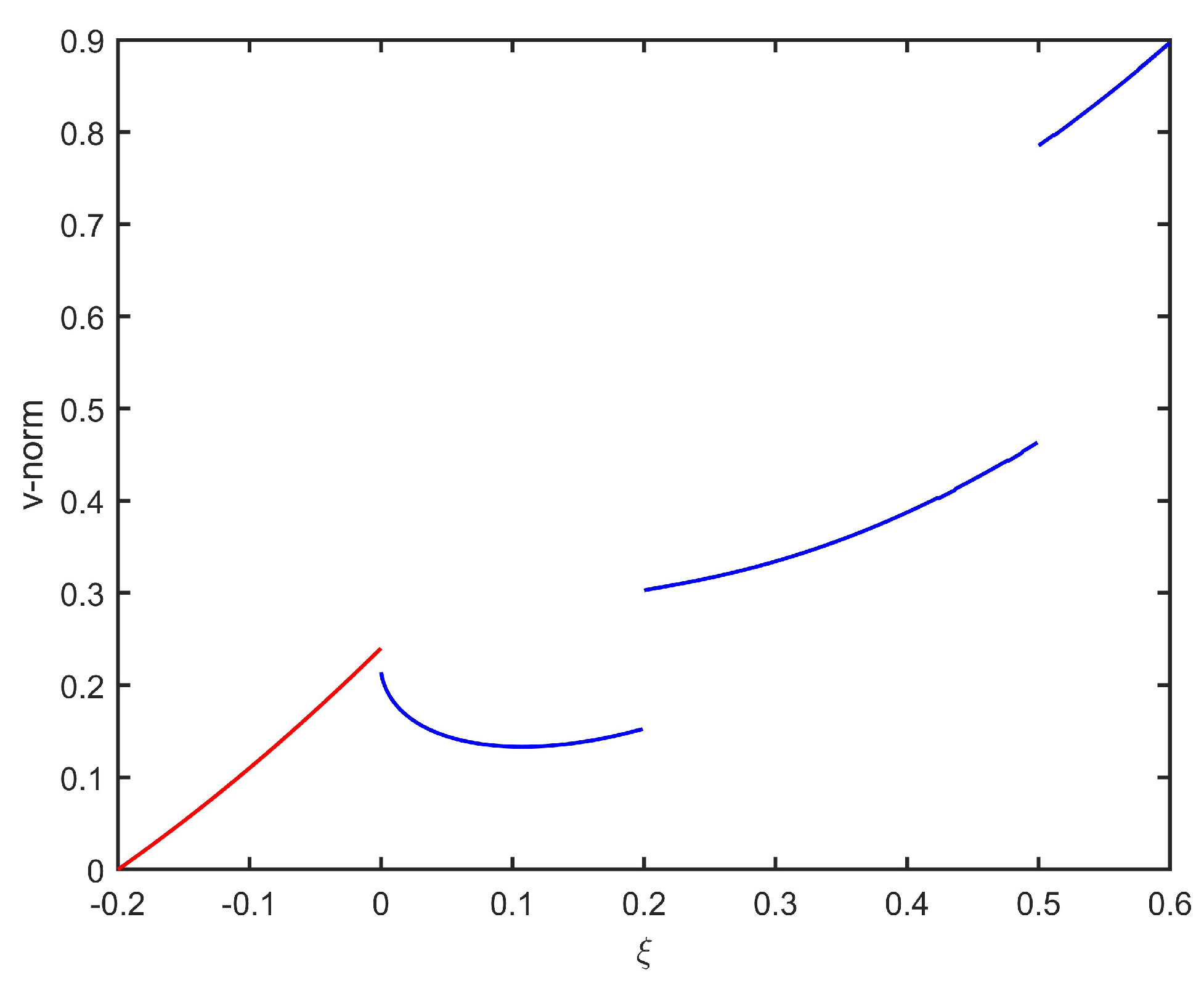1. Introduction
In recent decades, researchers have found that fractional differential equations are appropriate for describing real-life problems with memory and genetic characteristics. Thus, the topic of fractional differential equations has received increasing attention. More details can be found in [
1,
2,
3]. Impulsive fractional differential equations (IFDEs) are used to depict various practical dynamical systems, including the evolution of states that mutate into features at certain times, with the wide application of IFDE theory in the modeling of genetic phenomena and abrupt dynamical systems. The research on the existence, uniqueness and stability of IFDEs has attracted increasing attention [
4,
5,
6,
7,
8,
9].
At the same time, fractional delay differential equations (FDDEs) and impulsive fractional delay differential equations (IFDDEs) are often used to depict state changes that occurred in the time interval of the previous period. In [
10], the authors presented the idea of a delayed matrix function and provided an explicit formula for FDDEs by the method of constant variation. In [
11,
12], the idea of an impulsive delayed solution vector function was developed. This notion aided the authors in finding the exact solutions of IFDDEs. In [
13], the author obtained the exact solutions of higher-fractional-order nonhomogeneous delayed differential equations with Caputo-type derivatives by using the new generalized delay Mittag matrix function, Laplace transform and inductive construction.
The finite-time stability (FTS) of fractional differential equations has attracted much interest. After decades of research, FTS has contributed remarkable achievements in modern science and technology, chemical engineering, and other areas. Thus, we studied the FTS of a system, which is of great practical significance. Scholars have recently used the Lyapunov function, and Gronwall’s integral inequality to research the FTS of integer and fractional differential equations. In [
14,
15,
16,
17], the authors investigated finite-time stability by means of the generalized Gronwall inequality. Other related research can be found in [
18,
19,
20,
21]. Once we obtain the exact solution of the system, we can find a suitable method to obtain the sufficient conditions for FTS. Motivated by [
12], we seek to construct an impulsive delayed solution vector function to express the explicit solution and study the FTS of IFDDEs.
In [
22], the authors gave a representation of the solution of linear FDDEs:
where
denotes the Riemann–Liouville derivative (see Definition 2),
denotes the fractional integral (see Definition 1),
,
,
,
,
is a fixed delay time and
exists. For any
, the solution
of (
1) is given by
where either
for
or
for
.
In this paper, we deduce the general solution of linear IFDDEs:
where
denotes the number of impulsive points belong to
and the symbols
and
denote, respectively, the right and left limits of
at
.
After that, we will give some new sufficient conditions to ensure that (
4) is finite-time stable.
This paper mainly has the following three aspects of innovation:
(i) The mathematical model is novel, and the newly constructed impulsive delay vector function is of great significance for extending from time-delay systems to impulsive time-delay systems.
(ii) Using the relationship between the Riemann–Liouville fractional derivative and the Caputo fractional derivative, the two are skillfully transformed to prove that the impulsive delay vector function is the fundamental solution of (
3), which provides more ideas for future research.
(iii) The position of the pulse point in this paper is arbitrary, which renders the research more universal.
The rest of this paper is constituted as follows. Firstly, we review the symbols and definitions. Secondly, we construct an impulsive delayed solution vector function and give the explicit solutions of (
3) and (
4). Then, we give four practical conditions to guarantee that (
4) is finite-time stable. Finally, we give three numerical examples to illustrate our theoretical results.
2. Preliminaries
Let be the space of a continuous function with , . There exist and with with . For any , we denote with . Let , and .
Definition 1 (see [
2]).
Let and . The fractional integral of y is defined bywhere is the Gamma function. Definition 2 (see [
2]).
Let and . The Riemann–Liouville fractional derivative of y is defined by Definition 3 (see [
2]).
Let and . The Caputo fractional derivative of y is defined by Definition 4 (see [
2]).
If , y is a function for which the Caputo fractional derivative exists together with the Riemann–Liouville fractional derivative . Then,In particular, when , then .
Definition 5. The delayed one-parameter Mittag–Leffler-type matrix function is defined bywhere Θ
is a zero matrix and E is an identity matrix. Definition 6 (see [
22]).
The delayed two-parameter Mittag–Leffler-type matrix function is defined by Definition 7. For any and , the impulsive delayed Mittag–Leffler-type vector function is defined by Definition 8. System (4) is finite-time stable with regard to if and only if implies and , where and . Lemma 1 (see [
12]).
For any , and , we havewhere . Lemma 2 (see [
18]).
For any , and , we obtain that(i) For any , one has (ii) For any , one has (iii) For any , one haswhere , . Lemma 3 (see [
18]).
For any and , we have Lemma 4 (see [
18]).
For any , and , we have Lemma 5. For any and , we have Proof. By (
7), one has
The proof is finished. □
3. The Solution of System (4)
In this section, we will establish the general solution of (
3) by using (
6)–(
8).
Theorem 1. Let , and let be a fixed impulsive point. Then, we have Proof. By Definition 4, we have
where we use the fact
. We will split down the entire proof into three steps.
(i) For
, we have
By Definition 3 and Equation (
9), one has
(ii) For
, we have
By Definition 3, Lemma 1 and Equation (
10), one has
(iii) For
,
, we have
By Definition 3, Lemma 1 and Equation (
11), one has
The proof is finished. □
Theorem 2. The impulsive delayed Mittag–Leffler-type vector function is the fundamental solution of (3). Proof. By Definition 3 and Lemma 1, one has
Let
and
; we will prove
.
which implies that
. The proof is complete. □
Theorem 3. The solution of (3) has the formwhere either for or for . Proof. The proof of this theorem is analogous to ([
22], Theorem 3.2).
The general solution of (
3) that satisfies
,
has the following form
where
c is an unknown vector and
is an unknown function. We choose a
c satisfying
; then, one has
By (
6), let
, and we obtain
with
. For
, we have
which implies that
For any
, one has
Thus, for any
, we have
Using Riemann–Liouville fractional differentiation on both sides of (
13), we have
For any
and
, we have
This proof is complete. □
Theorem 4. The solution of (1) with can be written as Proof. The proof of this theorem is analogous to ([
22], Theorem 3.3). □
Next, combined with Theorems 3 and 4, the solution of (
4) can be obtained.
Theorem 5. The solution of (4) has the form Proof. Equation (
4) can be decomposed into (
1) and (
3) (where (
1) satisfies
); thus, the solution of (
4) can be manifested as
, where
is a solution of (
3) and
is a solution of (
1) satisfying the zero initial condition. □
4. FTS of (4)
Now, we will give the results of FTS.
.
, .
, , such that for and .
For every
and
, we define
and
Theorem 6. Suppose that and holds. Ifthen (4) is finite-time stable with regard to . Proof. By Lemmas 2, 3 and 5, we have
This proof is complete. □
Theorem 7. Suppose that and and hold. Ifthen (4) is finite-time stable with regard to . Proof. By Lemmas 2 and 4, we have
This proof is complete. □
Theorem 8. Suppose that and holds. Ifthen (4) is finite-time stable with regard to . Proof. By Lemmas 2 and 5, we have
This proof is complete. □
Theorem 9. Suppose that and and hold. Ifthen (4) is finite-time stable with regard to . Proof. By Lemmas 2 and 5, we have
This proof is complete. □
5. Example
Example 1. Let , , , and . Considerwhere By Theorem 5, for any
, one has
where
and
Set
,
and
. We can obtain that
,
,
,
,
. Next,
,
,
,
. Choosing
, we present the FTS results of (
18) in
Table 1.
By Definition 8, we find an appropriate
, ensuring that
in (
18) is no more than
on J. So, through numerical simulation, we can use the explicit solution of (
18) to find a suitable
for a fixed
(see
Figure 1). Furthermore, by verifying the conditions in Theorems 6, 7, 8, 9 for
, compared with the values of
in
Table 1, we can choose a better value of
.
Example 2. Let , , , and . Considerwhere By Theorem 5, for any
, one has
where
and
Set
,
and
. We can get
,
,
,
,
. Next,
,
,
,
. Choosing
, we present the FTS results of (
20) in
Table 2.
Like Example 1, we can choose a suitable
for a fixed
(see
Figure 2). Furthermore, compared with the values of
in
Table 2, we can choose a better value of
.
Example 3. Let , , , and . Considerwhere By Theorem 5, for any
, one has
Set
,
and
. We can get
,
,
,
,
. Next,
,
,
,
. Choose
, we give the FTS results of (
22) in
Table 3.
Like Example 2, we can choose a suitable
for a fixed
(see
Figure 3). Furthermore, compared with the values of
in
Table 3, we can choose a better value
.
Comparing Example 1, Example 2 and Example 3, we find the following: When the order is the same, the time delay is different, and when the time delay is the same, the order is different, and the system is finite-time stable.
6. Conclusions
In this study, we introduce the Mittag–Leffler-type vector function with an impulsive delay, and give the explicit solution of the Riemann–Liouville fractional differential equation using the constant variation method. On this basis, by scaling the base solution matrix and the integral, we verify that the system is finite-time stable. Finally, the results are verified by four examples under different conditions. In the future, we may continue to study the other properties of the system, including stability or controllability. Due to the importance of impulsive differential equations, we believe that the results obtained by us will arouse the interest of many readers.









